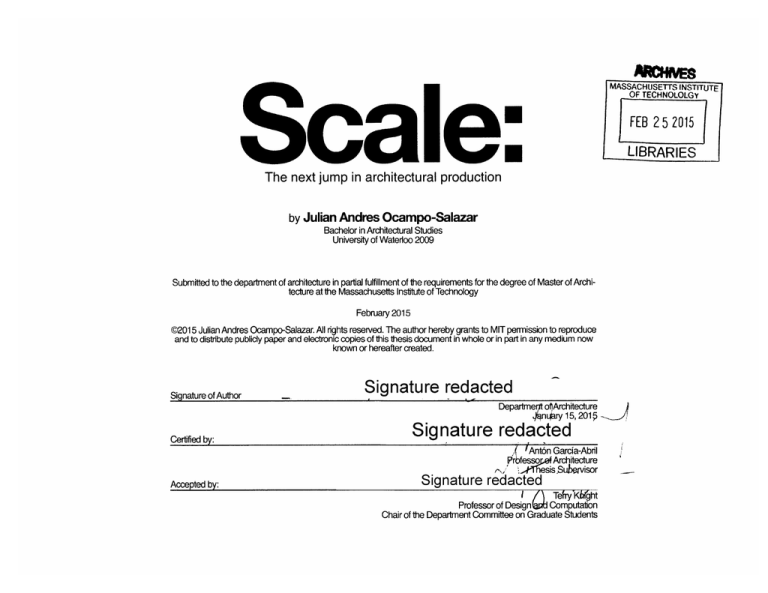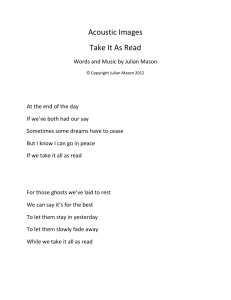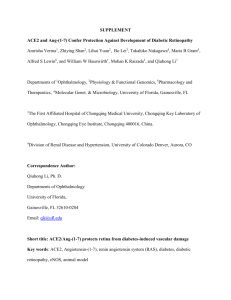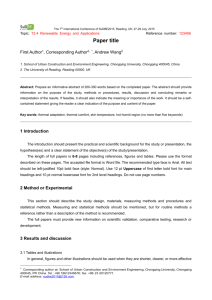
MASSACHUSETTS INSTITUTE
OF TECHNOLOLGY
FEB 252015
LIBRARIES
The next jump in architectural production
by Julian Andres Ocampo-Salazar
Bachelor in Architectural Studies
University of Waterloo 2009
Submitted to the department of architecture in partia fulfillment of the requirements for the degree of Master of Architecture at the Massachusetts Institute of Technology
February 2015
@2015 Julian Andres Ocampo-Salazar. All rights reserved. The author hereby grants to MIT permission to reproduce
and to distribute publicly paper and electronic copies of this thesis document in whole or in part in any medium now
known or hereafter created.
Signature of Author
Signature redacted
Departmer/t oftArchitecture
4AngLry 15,2015
by:
Signature redacted
i 'Ant6n Garca-Abril
Prbfesso;,ofArchitecture
*Thesis Subeivisor
Accepted by:
Signature redacted
I C Tefry'Kbfght
Computation
Professor of Design
Chair of the Department Committee on Graduate Students
Thesis Committee
Anton Garcia-Abril
Professor of Architecture, MIT
Thesis Supervisor
Joel Lamere
Professor of Architecture, MIT
Thesis Reader
Jeremy Alain Siegel
Designer, Bjarke Ingels Group
Thesis Reader
2 scale
Scale - The Next Jump In Architectural Production - Julian Ocampo
Scale:
The next jump in
architectural production
by Julian Andres Ocampo-Salazar
Submitted to the Department of Architecture on January 15, 2015 in partial fulfillment
of the requirements for the degree of Master of Architecture
Abstract
As a result of macro-economic trends as well as extensive support
from the Chinese central government and its 'Go West'initiative
Chongqing has become the fastest growing large city in the world, with
annual GDP growth of 15% and a continued economic expansion that
has facilitated the conditions for unprecedented urban development
both in terms of size and speed.
In the year 2013 half an Empire State building was constructed in
the city every day, an equivalent of 182 Empire State buildings in
one year, a massive amount of architectural production for a single
city. Chongqing has followed the default growth paradigm of isolated
multi - tower - in - the - park developments located at the periphery of
the city that are, by default, conceived in isolation; this paradigm fails
to envision the concurrent architectural production within the city as
a possible force that can be focused and utilized to shape the urban
experience, reduce overall transportation time, reduce energy consumption and make evident the reality of the scale at which the city is
growing.
Scale, The next jump in architectural production proposes an alternative development model that capitalizes on the opportunities embedded within the unprecedented scale of concurrent development taking
place in Chongqing. By understanding this development as a confluent force Scale proposes a system through which buildings previously
thought of as single use become multi - use infrastructural parts of a
much larger architectural object, a single "building made of buildings".
Typical generically designed housing and office towers become the
columns supporting city blocks turned elevated beams that assemble to form a new infrastructural object. Such an object fulfills the
immediate programmatic requirements of the city below; education,
housing, offices and public space as well as transportation are embedded within, giving the new architectural object the ability to intensify
the gravitational pull of the city towards itself and serves as a marker
showcasing the unparalleled scale of architectural production that the
city of Chongqing is currently able to generate.
Thesis Supervisor: Ant6n Garcia-Abril Professor of Architecture, MIT
julian ocampo
3
Acknowledgments
La Familia
To Mother, Brother, Sister and Father total gratitude for the
consistent support and encouragement.
Ant6n Garcda-Abril
Many thanks for your time, dedication, wisdom and continuous
words of encouragement. I will keep the aluminum model but you
can have the test piece.
Joel / Jeremy
Thanks for the invaluable advise and for your willingness to
spend time talking about this thesis, your advise came at critical
times and made it a lot easier to navigate this whole thing.
Justin Lavallee
For your generous help during the making of the aluminum
model, I would still be watching the mill break bits if it wasn't
for you, this and all the extra time you spent with me figuring
everything out makes you the real hero in my book.
Eryone
4 scale
Thanks to Chris Green for killing with images.
Grisha and Philip, your assistance in the last moments of
madness was mission critical, many thanks.
Index
Chongqing
Scale - Context
Default
What if we do nothing?
The Future
Proposal
Appendix
Panels - Models - Bibliography
6
24
34
90
julian ocampo
5
Scale
"Scale it links the process of design to the process of building,
leverages the systems of proportion, orders part to whole,
and allows buildings to relate to one another. However,
recent developments in modeling tools (the scalelessness
of digital space), fabrication (the increasingly seamless
translation of this scaleless digital space into physical space),
and the homogenizing pressures of globalization (the loss of
local context), have upset these traditional registers, leaving
the status of scale increasingly uncertain and in need of
reformulation."']
It is this opportunity for reformulation that is most apparent
in the one place on earth where architectural production has
reached an expanded new scale, the city of Chongqing in
central China.
Architectural production in Chongqing has reached
an unprecedented pace and scale, unfortunately this
condition has not been considered as such, creating a
situation where development in parallel misses the great
opportunities that consolidation and scalar expansion bring.
8 scale
Graphics exploring the current limits of scale in architectural production.
The images show an exponentially expanding context with an overlay
fixed size reference form as a stand-in for a potential architectural
product21
julian ocampo
9
Chongq ing
Is a major city in Southwest China and one of the five national
central cities in the People's Republic of China (PRC).
Administratively, it is one of the PRC's four direct-controlled
municipalities (the other three are Beijing, Shanghai and
Tianjin), and the only such municipality in inland China.
The municipality was created on 14 March 1997, succeeding
the sub-provincial city administration that was part of
Sichuan province. As of 2010 census, the municipality
had a population of 28,846,170. According to this census,
Chongqing is the most populous and largest direct-controlled
municipality in China, and comprises 21 districts, 13 counties,
and 4 autonomous counties.
-World's fastest growing large city, with annual GDP growth
exceeding 15%
10
scale
- Extensive support from the central government and its 'Go
West' initiative and high visibility due to Chongqing's status
as the only provincial-level municipality in inland China
- Inland focus is structural and has underpinned strong
economic growth. Chongqing has continued to see doubledigit FDI growth in 2012
- Cheap labor is not the only draw. Infrastructure
improvements and favorable policies have successfully
attracted key multinationals and their supply chains
- Chongqing has established 'scale' and a strong reputation in
its manufacturing sectors
- Logistics real estate is under-provisioned - improving
infrastructure and greater domestic and international
integration is driving demand.
Chongqing in the world.
V
-
Chongqing
julian ocampo 11
ii
Special Municipalities
12 scale
Roads
0
High Speed Rail
Rivers
julian ocampo
13
Chongqing Municipality
MOne Hour Economic Circle
E.-1.': The Two Wings
14 scale
Chongqing Highways
= Built
.
Projected
YoglSz Rr
Chongqing Trains
Chongqing Rivers
=
In Operation
U Planned
julian ocampo 15
The New
Silk Road
Macroeconomic factors such as the annual growth in bilateral
trade between China and the European Union (from 546 Bn
Dollars in 2012 to 594 Bn in 2013) combined with the 2012
opening of the rail connection between Chongqing and Duisburg in Germany (largest in land port in the world) garantee a
solid economic underpinning for the continued need for urbanization in the city of Chongquing.
Over the past decade, the Chongqing municipality has seen
increasing industrial specialization, particularly in its traditional
heavy industry sectors. Significant mineral and other natural
resources, as well as abundant (albeit lower-skilled) labor, have
provided a considerable competitive advantage for the city to
attract investment in manufacturing and chemical processing.
16 scale
Furthermore, its healthy rivalry with neighboring inland cities,
particularly Chengdu, has ensured that securing reforms and
favorable policies, enabling it to remain competitive, continues
to be high on Chongqing agenda.
The increase in manufacturing and logistic capacity as well as
extensive support from the central government and its 'Go
West' initiative make the rapid urbanization of Chongqing a
country wide priority.
A Faster Route for Trade
Eu......
i
16 Days - International Railway
36 Days - Maritime Transport
or
4
julian ocampo
17
7.3m
NYC
Chongqing
Population Growth
In order to establish a reference, we can see how population growth
in the city of Chongqing compares to a city we are more familiar with,
the city of New York. it is to be noted that the population of city of
New York is taken from its administrative boundaries, excluding its
extended population.
18 scale
NYC
Chongqing
Tallest Buildings
julian ocampo 19
Pace of
Growth
In the year of 2013 the city of Chongqing grew its real estate
stock by a factor of 1/2 an Empire State building per day, 182
Empire State buildings per year.
With its relatively low current rate of urbanization at 53%1 and
its designation as a pilot for rural-urban reforms, Chongqing's
urbanization rate is projected to reach 60-70% by 2020.
This goal, along with the city's inherent cost advantages
(derived from its abundant land and labor resources), improving
transport links and central government support, make
Chongqing an increasingly attractive destination for domestic
and foreign investors.
20 scale
1111111 jIllIllIllIlli
1111111 I 11111 It
1111111 I iii" 111 It
1111111 it I 11111 III It
1111111 it I 11111
1111111 I 'liii
1/2 Empire State
Building a day
182 EmpireState
Buildings a year
Real State Built in Chongqing in 2013
julian ocampo
21
Chongqing
A relatively small city until the second world war
when military and heavy industrial production
was moved into the city in order to secure it
from Japanese bombardments. The city then
started an exponential pace of growth.
New York City
We can see a much more gradual growth from
1760 to this day, with the largest urban area
expansion taking place in the early 1900.
1760
22 scale
1890
44
le
.-
4
4.,
g
.5
N
t'<
#~r-
k44
~
*1
top
1950
*
.,
4,
2010
A,
'
W,'A
Ar
AA
2020
julian ocampo 23
Default
"Default is what we're left with when no one chooses for
anything else to happen.
It is what we resign ourselves to. It represents a lack of
agency. A failure of vision. It is the least common denominator.
Mediocre. Banal. Bland. Generic. It is what slips through when
we look the other way, when we're distracted, when we're too
busy, or when weve given up.
And yet, the default also constructs commonality and cohesion.
It can create a shared legibility, a visual language available
26 scale
to a broad and diverse public. It is the field, the mood, the
ground that enables the figure. The assumption is that design
inherently denies the default, and that the default is by definition
un-designed. Buildings are default, while architecture is its
opposite - exceptional and deliberate. 31
In this chapter we explore what happens if we do nothing, If we
offer no alternatives to the current growth paradigm.
I
Office
I
i
----------
Retail
i
I
I
l
Other
H
Residential
1/2 Empire State
Building a day
182 Empire State
Buildings a year
Real State Built in Chongqing in 2013
julian ocampo
27
II
III
1 Empire State
Building
28 scale
9 Typical housing
towers
Equivalent of one Empire State Building in terms
of the typical Chongqing housing tower
...
..
........
''''III''''''
''''III''''''
''''III''''''
''''III''''''
'"'III''''''
''''III''''''
I'll'"''
I,'''''
I'll',,
I'll'''
I'll'''
I'll'''
I,'''''
I'll'''
I'll,''
I'll'''
I'll'''
I'll'''
I'll','
I,'''''
I'll'''
II,''''
'''I'll
I'll'''
I'll'''' I'll'''
I'll'''' I'll','
I'll'''' I'll'''
I'll'''' I'll'''
I'll'',' I'll','
I'll'''' I'll'''
I'll''''
I'll'''
I'll'''
''''I'll
IIIIIIII II,,','
I'll''''
I'll'''
I'll''''
I'll'''
I'll''''
I'll'''
I'll'''
I'll''''
I'll''''
I'll'''
I'll'''' I'll'''
I'll'''' I'll'''
I'll''''
I'll'''
I'll'''
I,'''''
'I'll''
I'll'''
I'll'"I
I'll'''
I'll'''
I'll'''
I'll'''
I'll'''
I'll'''
I'll'''
I'll,''
I,'''''
III,'''
I'll'''
I'll'''
1188 Typical housing towers buift in 2013
Equivalent of Housing stock production in a single year
julian ocampo
2
SSha
-
fngbei
nping
*'Chayuan
x12
Chongqing 2013
-t
~'
I
Chonqing is a multi nodal city, with several
business centers dispersed in an otherwise
homogeneous urban landscape with a nascent
subway system connecting the nodes and
extending towards the north and south, where
most future growth is expected.
L1
ng
4
ing
ha
n
x21
Projected Chongqing 2020
Area of projected growth along the north south
axis. Significant resources are to be deployed
to extend basic city services to the new areas.
Outward expansion also projects the significant
cost of transportation to and from established
centers.
julian ocampo 31
6
Typical high-rise development
Typical section of a newly developed
area in the expanding front of the city.
32 scale
Open space
Open space is seemingly abundant in
the "tower in the park" model
Open space minus private land
Public space minus roads
BUT Most of this open space is hidden
behind fences, inaccessible to the
general public.
Resultant public space is constituted
by sidewalks and disembodied,
residual areas in between highways
julian ocampo 33
.#--: :::s:~::as"
5t.
~~x~
:... ....... .. . .. :::::::2::222
: x
.--
00
a!!!!!!!::
dlS
II
abuil ding
bmade of
uildings
In Chongqing The speed of development
makes the design of each individual
building impractical and economically
inviable, Scale proposes a system that
organizes architectural production into
a cohesive whole, where each building,
designed generically as a unit for
aggregation, a component of a larger
architectural form.
36 scale
II 'III''''''
II 'III''''''
II 'III''''''
II 'III''''''
II 'III''''''
II 'III''''''
II ''''''III'
II 'III''''''
II 'III''''''
II 'III''''''
II 'III''''''
II 'III'','''
II 'III''''''
II 'III''''''
II 'III',''''
II 'III',''''
II 'III''''''
II I'll'''
I'll'''
I'll'''
I'll'''
I'll'''
I'll'''
I'll'''
I'll'''
I'll'''
I'll'''
I'll'''
I'll'''
I'll'''
I'll'''
I'll'''
I'll'''
I,'',''
I'll'''
I'll''''
I'll''''
I'll''''
I'll''''
I'll''''
I'll''''
I'll'','
I'll''''
I'll''''
I'll''''
I'll''''
I'll''''
I'll''''
I'll''''
I'll'','
I'll''''
I'll''''
I'll'''
I'll'''
I'll'''
I'll'''
I'll'''
I'll'''
I'll'''
''I'll'
I'll'''
I'll'''
I'll'''
I'll'''
I'll'''
I'll'''
I,'''''
I'll,',
III,'''
11
Jot
Upp
-.
%~
p
-
I WE
IL .-. -to,-
c
T
I
It
v1
I
11
p4l1
I
Central Chongqing
40 scale
-
Y
Main Business Distbicts
B9
-I
WV-
4
4:
4
oir,
A,
The Ring
As a result of macro-economic trends as well as extensive support
from the Chinese central government and its 'Go West'initiative
Chongqing has become the fastest growing large city in the world, with
annual GDP growth of 15% and a continued economic expansion that
has facilitated the conditions for unprecedented urban development
both in terms of size and speed.
In the year 2013 half an Empire State building was constructed in
the city every day, an equivalent of 182 Empire State buildings in
one year, a massive amount of architectural production for a single
city. Chongqing has followed the default growth paradigm of isolated
multi - tower - in - the - park developments located at the periphery of
the city that are, by default, conceived in isolation; this paradigm fails
to envision the concurrent architectural production within the city as
a possible force that can be focused and utilized to shape the urban
experience, reduce overall transportation time, reduce energy consumption and make evident the reality of the scale at which the city is
growing.
42 scale
Scale, The next jump in architectural production proposes an alternative development model that capitalizes on the opportunities embedded within the unprecedented scale of concurrent development taking
place in Chongqing. By understanding this development as a confluent force Scale proposes a system through which buildings previously
thought of as single use become multi - use infrastructural parts of a
much larger architectural object, a single "building made of buildings".
Typical generically designed housing and office towers become the
columns supporting city blocks turned elevated beams that assemble to form a new infrastructural object. Such an object fulfills the
immediate programmatic requirements of the city below; education,
housing, offices and public space as well as transportation are embedded within, giving the new architectural object the ability to intensify
the gravitational pull of the city towards itself and serves as a marker
showcasing the unparalleled scale of architectural production that the
city of Chongqing is currently able to generate.
*
*
-V.
I
*
I'
C
J N
-.
I..'
-.
3~r
C1
,
?1
kvi K'~ill
-'
SLH
f
u
'i JA:
o
CAP' ;jjW:
Vto
.
cI~~A4s~
rr, n
-.
-
C
~
aS
-w
*.
1w
*1,
w .2-lg
~
*n
*
~
~
-
~A
Lo 1
L.
0
vt'-:
R.14
*
4
*4t.
dod
.-
SF'
'.o
~p~j%~~
~
-~4
$~f.
%1r
*AAt*f:
IP-wgp.'
4
r~
W
)rflg
Zt~a~Y
p
,eY'~
AW4we
-r~l.
g'a,
Vo
I
4i:0
V~7,
Iuu~
*9\
ANN
flu
~
'fp
4m
4
* .1') '
ti Az-m
inf )?UA
W'4
r'tf
~
IV
tu
oi
f
y
clet
IJYc'
I
all
for
9
r r A.
49-
t';41t~ 5%
4
SONE
I"
-"I
'.,a
ra
C .9
.
Wr~
.~gI
-
--
~
'.
'-~.
Typical Sites
In order to study the effects and possibilities of an intervention at such
a scale, we have identified 4 site typologies that serve as an example
of other site conditions found throughout the city.
;~yK-
The ground level in these 4 site typologies is studied for factors such
as FAR, programmatic makeup and potential impact area. It is in the
interpretation and implementation of this analysis that the Ring gains
agency, the ground below informs the formal / programmatic formulation for the ring supports and beams above; for example, in a heavily
residential area there might be a lack of education and recreational
facilities so the beams above will make up for the imbalance, always
keeping in mind that the infrastructural and transportation components
of the ring above are public and always open to the rest of the city.
4 scale
,-r
7-~
~.p.
~
~
-o
i
Residential
Sites that consist mainly of
residential tower-in-the-park
developments
Mixed Low Rise
Office / Mid Rise
Highest land elevation along the
The most prevalent site
typology, a mixture of new
development and older mid rise
buildings.
ring, with a lot of govemment
and healthcare facilities
New Development
Spaces within the city that
are only now being opened to
development, encompassing
completely undeveloped areas.
julian ocampo 45
Site Type 1
Residential
Sites that consist mainly of residential tower-in-thepark developments
46 scale
julian ocampo 47
r4
where
Open space is seemingly abundant in the
"tower in the park" model
48 scaie
landing
Open space is seemingly abundant in the
"tower in the park" model
ewe..
Iw
0)
FAR
program
Open space is seemingly abundant in the
Open space is seemingly abundant in the
"tower in the park" model
Ift
141fillielitl
"tower in the park" model
At
IA .4 k*jj
c4t,...
C
Z!.4:
julian ocampo
49
2014
2010
FAR 1.32
FAR 2.01
ExsUng
Open space is seemingly abundant in the "tower in the park" model
50 scale
2018
2020
FAR 2.39
FAR 4.20
Proposal
Open space is seemingly abundant in the "tower in the park" model
julian ocampo
51
Site Type 2
Mixed Low Rise
Highest land elevation along the ring, with a lot of
government and healthcare facilities
54 scale
_:;Wow
julian ocampo
55
where
Open space is seemingly abundant in the
"tower in the park" model
56 sca6
landing
Open space is seemingly abundant in the
"tower in the park" model
1.26
2
C
tE
C
--
I
0
0
FAR
program
Open space is seemingly abundant in the
Open space is seemingly abundant in the
"tower in the park" model
-.ioaw zor
"tower in the park" model
9 It
kit At iaw,
,,....z.. campo
57
2014
2010
FAR 1.02
FAR 1.26
Existing
Open space is seemingly abundant in the "tower in the park" model
58 scale
2018
2020
FAR 2.52
FAR 1.57
Prpo
Open space is seemingly abundant in the "tower in the park" model
julian ocampo
59
Site Type 3
Office / Mid Rise
The most prevalent site typology, a mixture of new
development and older mid rise buildings.
62 scale
i No!
julian ocampo
63
where
Open space is seemingly abundant in the
"tower in the park" model
64 scwe
landing
Open space is seemingly abundant in the
"tower in the park" model
2.364
0
C
4)
'V
E
E
4)
0
FAR
Open space is seemingly abundant in the
"tower in the park" model
Ran~
~
7I
pwgram
Open space is seemingly abundant in the
"tower in the park" model
uAX",AIL'i
julian ocampo
65
;e
2014
2010
FAR 1.02
FAR 1.26
ExisUng
Open space is seemingly abundant in the "tower in the park" model
66 scale
2020
FAR
2018
FAR 1.57
3.52
Poposal
Open space is seemingly abundant in the "tower in the park" model
julian ocampo 67
Site Type 4
New Development
Spaces within the city that are only now being
opened to development, encompassing completely
undeveloped areas.
70 scale
I
I
julian ocampo 71
-P
where
Open space is seemingly abundant in the
"tower in the park" model
IJIIrIra
72 scle
landing
Open space is seemingly abundant in the
"tower in the park" model
~I
Iii U I
1 49
FAR
Open space is seemingly abundant in the
"tower in the park" model
0
E
C,
E
CD
A2
I
program
Open space is seemingly abundant in the
"tower in the park" model
julian ocampo
73
IK
2014
2010
FAR 0.87
FAR 1.54
Existng
Open space is seemingly abundant in the "tower in the park" model
74 scaie
2018
2020
FAR 2.16
FAR 4.08
Proposal
Open space is seemingly abundant in the "tower in the park" model
julian ocampo
75
I
0
ON 19i [ "0-1
Columns
A structural vocabulary is developed using the exiting housing
towers characteristic of Chongqing as a base from which to
draw our initial conclusions. The towers are re-designed to perform more functions than the ones they are currently used for.
Housing towers stop being the end product of urban development and become the facilitator for new possibilities, the literal
structure of the evolving city.
80 scale
lIJiJI) 4 S~di~N
+
4$
~
44
4
*Z*
%*%
*
*
~4444
+
at
julian ocampo 81
4t
$
b1
..
.
i
w
#4*:*
>11
I.
C
Beams
Spanning between the re-engineered towers are the re-configured city blocks in the form of an inhabitable bridge beams.
each bridge beam spans 85 mts from end to end and is responsible of holding its own weight as well as a 12 mt cantilever
on either side. The new beam - blocks form a reconfigurable
three dimensional real estate, that is divided in units of volume,
in conquering the air, the new real state moves away from the
planar division of space and allows for more flexibility within a
three dimensional grid
84 scale
1imir'
7 -\I/
N
L4"1N
N'
""
D
N'
n=
I I
K,
)0
julian ocampo
85
m, f
I
I
W-
..
I* I
S. W
I
q
Longitudinal Section
Showing 3 different tower typologies as well as 3 different beam
typokgies being held together by a uniform capitol design.
88 scale
F
ItA,.AW4
,twt
III
~miaaM~
if
service f loor
VV-
- ~ 10171
LIl
LJ
Transversal Section
Showing the diversity in program and public space within the ring,
including metro, service and emergency circulation.
julian ocampo 89
--
24
",v
Ul
t
1
Im
Renders
92 scale
Ringoemp
w
julian ocampo 93
River Crossing
94 scale
Tower Construction
julian ocampo 95
Among aparment twers
96 scale
Ringside
julian ocampo 97
. ...
......
....
.. ....
..
....
. ....
Inuxior
julian ocampo
99
L
cit
0I
U
E01 01
E
43
I
j
J1
H
N
I
I
w
I
dofatit is
=~
-
iii
1=111
Liii
~-
a bulg mad ofbungs
-
-
-
A
I
-
'zil
/AM1.
0~e
==
*i.g*
IF4
d~l i-
julian ocampo 101
abm IMMW
rn-rn
O
,r
, =r
sflstypology2
sbeypoogy14
JeJ1
+.4
#N~ + x
Wflauai
0AI
44.,"A 4,
4W*U
At
~
44*R
4
d *
2O
2M4Am
2M4
2
0
A-t
102 scale
2rr
.*
IrwIxr
FAR 2A1
ma
I
I
I
I I
I, I I I I
I
FMIM
-C
t4
-
--
-wIAm
--
0O
m
wk
MIS
-
20
2M4
-
m
2m
.a.
-
20"
No..*I
sitetypology 4
ottpology3
julian ocampo
103
Models
104 scale
Tow Typology Studies
julian ocampo 105
Ph
AY
f
6i
E
I
I
VF
I
ii
Consbrunon concept Model
julian ocampo 109
OWN-
-.1
1-
- --
Assembly Model
julian ocampo 111
mm"n-m-m
112 scawe
Srte Model Process
julian ocampo 113
- Im
1I~
-m'4<
tod
Site Model 1:10.000
114 scale
Site Model Close-Up
julian ocampo 115
Thesis
Defense
December 18 2014. Media Lab MIT
Thesis Review Panel:
Amanda R. Lawrence.
Igor Marjanovic.
Pierre Belanger.
El Hadi Jazairy.
Simon Frommenwiler.
Nader Tehrani.
Nasser Rabbat.
Andrew Scott.
Anton Garcia-Abril.
Joel Lamere.
116 scale
E-
i
118 scale
(0
-L
-""" """"
i i
"-"" mmii=1111111111111""="
".""
="" unnu
-
--
-"
-
"""
'.""""'""""
""""
" "" ""'
Bibliography
Valle, Giancarlo and Ryan Neiheiser. Another Pamphlet: Scaleless!,
Accessed March 13 2014, http'/ww.anotherpamphlet.com/
M Boeke, Kees. Cosmic Wew;.
New York: J. Day, 1957
NAValle, Giancarlo and Ryan Neiheiser. Another Pamphlet: Default!,
Accessed February 20 2014, http-A/ww.anotherpamphlet.com/
Koolhaas, Rem. Small, Medium, Large, Extra-large: Office for Metropolitan Architecture, Rem Koolhaas, and Bruce Mau.
New York, N.Y.: Monacelli Press, 1995.
Garcia, Cruz, and Nathalie Frankowski. Pure Hardcore Icons:A Manifesto on Pure Form in Architecture.
London: Artifice Books on Architecture, 2013.
Blanciak, Franc. Siteless: 1001 Building Forms.
Cambridge, Mass.: MIT Press, 2008.
Cook, Peter. Archigram.
New York: Praeger Publishers, 1973.
SUPERSTUDIO. 'Twelve Cautionary Tales for Christmas.".
A.D. Architectural Design, December 1, 1971, 737-42.
120 scale
Friedman, Yona. "Principles Ville Spatiale." Accessed September 1, 2014.
http-//ww.yonafriedman.nL/?pageid=396.
Jones Lang Lasalle. China's City Winners, Chongqing City Profile.
Global Foresight Series, 2013.
"2011 Chongqing." 2011 Chongqing Statistics. January 1, 2013.
Accessed September 4, 2014. http-/www.cqtj.gov.cn/html/jsj/tjgb/1 2/0215842.html.
"Chongqing.". Wikipedia. Accessed September 9,2014.
http-/en.wikipedia.org/wiki/Chongqing.
julian ocampo 121
.
. ......
............
...............
I
S
I-raw,
~
~
A
~
a
~
*~~~1
~ ~;
e
~
4~%alll
itI
Vr~
A.




